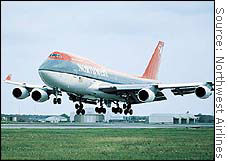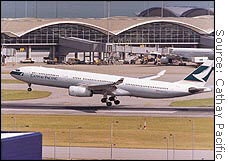NEW YORK (CNN/Money) -
The war may be behind it and billions in federal dollars may be on the way, but the U.S. airline industry still will have a difficult time climbing back to profitability anytime soon.
The perception that the war in Iraq essentially is over apparently has stopped the slide in bookings on U.S. airlines, according to industry officials. American Airlines, the industry's largest carrier, apparently will avoid a bankruptcy filing -- at least for now -- after winning labor contract concessions that should save it $1.8 billion annually.
 |
|
| Northwest Airlines posted a first quarter loss even larger than it posted in the fourth quarter of 2001, in the immediate wake of the Sept. 11 attack. |
Three of the nation's five largest airlines -- Delta Air Lines (DAL: Research, Estimates), Northwest Airlines (NWAC: Research, Estimates) and Continental Airlines (CAL: Research, Estimates) -- reported sharply wider first-quarter losses, with the red ink approaching or passing the levels seen in the fourth quarter of 2001, in the immediate wake of the Sept. 11 attack. Northwest's loss was less than analysts had forecast, but larger than it reported in the fourth quarter of 2001. The other two were only slightly below the consensus forecast.
To save money, American Airlines said Thursday it cut its management staff by 5 percent, effective immediately, on top of a 22 percent reduction in management since 2001. Delta and US Airways also announced further staff cuts Thursday. Delta said the war in Iraq was forcing it to furlough a total of 200 pilots during April and May. The pilots are the only unionized group of employees at Delta. US Airways announced it would lay off 890 flight attendants at the end of June.
"We hope that this is the end, and that it starts turning up," Association of Flight Attendants spokeswoman Dawn Deeks told Reuters Thursday. "But after being in this industry the past couple of years, everyone is really wary about what's next."
The Air Transport Association, the airlines' trade group, reported Wednesday that the decline in traffic seems to be turning around. System-wide traffic for its members was off 10.6 percent from year-earlier levels for the week ended April 13. But that's an improvement from the 17.4 percent year-to-year decline posted a week earlier. Bookings for this weekend's Easter holiday apparently are strong, according to an industry economist.
"That's continuing a pattern we've seen since 9/11, where holidays strongly outperform the non-holidays periods, more than they did in the past," the economist said. "People are concentrating their travel, taking the trips that count for them."
 |
|
| Hong Kong-based Cathay Pacific Airways has cut its schedule by 42 percent due to concerns about SARS. |
But just as airlines are seeing some improvement due to lessening war concern, they are being hit by a drop in trans-Pacific traffic due to concerns about severe acute respiratory syndrome (SARS), a deadly virus that has prompted world health groups to advise against travel to parts of Asia.
"While positive news about the war in Iraq and lower fares are bringing improved traffic results in some regions, progress is being eroded by significant declines in the Pacific, driven by SARS worries," ATA CEO James May said.
Hong Kong-based carrier Cathay Pacific has halted 42 percent of its schedule due to reduced demand for flights, and other carriers have suspended or severely cut back on their flights to the region. The Business Travel Coalition survey of 1,824 travel and purchasing managers found that 61 percent now have policies banning travel to Asia, up from 27 percent in an April 1 survey.
Philip Baggaley, the managing director for airlines and aerospace companies at credit rating agency Standard & Poor's, said it's difficult to know how widespread and long-lasting the impact from SARS concerns will be on travel.
"That is a very uncertain threat and it is pretty much unprecedented," he said. "The impact of what SARS has done to Cathay Pacific almost approaches the effect of a strike. But so far it is quite localized. If you begin to have more incidents in the United States, with passengers exposing others to the virus, that could scare more people."
Even if there were no SARS worries, it could take a while for demand to recover from the hit it took with the start of war in Iraq. It took about two months after the end of the first Gulf War in 1991 for traffic on U.S. airlines to return to year-earlier levels. And there are many in the industry who believe that traffic could take longer to rebound this time.
"People have [a] fear of terrorism when they fly now that they didn't back then," the industry economist said. "That doesn't mean air traffic will lag all year long. But it'll probably take several more months."
Most major U.S. airlines have been cutting capacity in response to lower demand for air travel. But there still is overcapacity, which is driving fares lower and hurting profits even more.
"A lot of the summer travel will be done at fairly low yields, generated from pretty aggressive discounting on fares," the industry economist predicted.
The clock is ticking for the industry. It needs a strong summer travel season, which traditionally begins Memorial Day weekend, now less than six weeks away. But some believe that even if it starts slowly, there will be enough vacation traffic for the industry suffering from overcapacity.
"They have enough time to capture most of the summer travel season," S&P's Baggaley said. "Passengers have tended to book closer into their trips. Not as if everyone's summer plans are set in concrete. If serious fighting had lasted into May, it would have been dicey for them."
Click here for a look at airline stocks
The airlines are helped by a nearly 30 percent drop in jet fuel prices since they hit highs in February. Fuel is the second-largest cost after labor.
The airlines also should get a boost from legislation signed by President Bush Wednesday that will give them $3.5 billion in assistance. About $2.4 billion will come in the next 30 days as pre-tax cash reimbursements for money the carriers already have spent.
An estimated $500 million will be saved on future security fees from June through September. Another $600 million is expected to be saved on insurance premiums by the extension of a federal insurance program.
But industry observers worry that all those savings could be wiped out if there is another act of terrorism that raises new concerns about air travel.
"It's tough to know what kind of attack would have what impact," the economist said. "It would probably have to be something on U.S. soil, but not necessarily against aviation directly, to have an impact on domestic travel."

|

